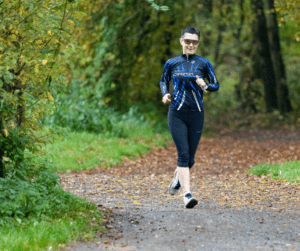It’s incredible that a volunteer-led, free-for-all 5k event has been taken up by so many people across so many cultures in so many countries!
The first-ever Parkrun event was in Bushy Park, Teddington, in the UK, where 13 intrepid parkrunners got together on 2 October 2004.
Fast forward a few years, with ramped-up technology and now hundreds of thousands of people make up the Parkrun community. All based on the same principle… Weekly, free, 5km for everyone!
Parkrun is a fantastic event. Now that Parkrun is open again, it’s happening around the world and people are running every weekend.

If you’re wanting to start running, then Parkrun is THE best way to go about it...
This is how to go about training for your first one.
Runners are inevitably going to try to beat their PBs. We wouldn’t recommend doing this weekly… Maybe every 3-4 weeks.
So, let’s have a look at how you can do just that…
The Parkrun Distance Is Achievable
Part of the reason why Parkrun is such a success is that it’s one of the classic distances.
It’s short, so if you want to get started, it’s achievable.
If you haven’t run for 30 years, then 5 km is a long way, but it’s reachable for most – families, dogs, aunts, uncles, and grandparents all complete the 5km whether it’s by walking or running or by doing a little bit of both.
That’s the great thing about Parkrun, you’re made to feel a part of the community even if you complete the 5 km by walking as slow or running as fast as you would like.
For those who would like to go “all-out”, then 5K is about as close as you can come to go all out and being able to hold it for 5K’s. It’s a really great distance for people to train hard for.
For those of you who are training hard, this might be for you!
How To Run A CRAZY Fast 5k: The Simple 5 Step Process To Improving Your 5k Time
Let’s dive into what you should be doing to beat your Parkrun personal best…

Training Consistently & Improving Coordination
Training Consistently
The first and biggest improvement that everybody will achieve in the beginning comes from training consistently.
Consistent training needs to happen in the aerobic zone, or as I like to say, running very, very easy.
Although running easy isn’t the only thing, we also suggest some interval/speed sessions.
The consistency is more about building days on days, weeks on weeks, months on months. Much like a financial investment, small contributions over time yield a big result.
One of the ways to do this is to stay injury-free and one of the ways to stay injury-free is to not run all your easy and long runs TOO HARD.
Coordination
One of the things that we need to run extremely fast, is very good coordination.
Part of what we do when we actually run faster and train harder and do speed work – is that we are improving our coordination and we are improving the body’s ability for the muscles to contract and relax faster, and contract and relax in a coordinated fashion.

There are two ways to would work on your coordination…
- Shorter, Faster Workouts
Have a look at your 5k time that you currently running at Parkrun and then you can design a whole lot of workouts.
Some of the workouts should be slightly shorter, and some need to be slightly longer, but they all revolve around the key concept that you want to be running between five and eight seconds per kilometer faster than you’re running in that 5k Parkrun.
We can manipulate a couple of things around the threshold for faster workouts.
In essence, you’re forcing yourself to run faster, so to avoid injury, this needs to be done for shorter periods of time, to improve your coordination while working on your anaerobic energy system, but at a much lower risk.
No Sprinting!
Not everything should be done at max! We are looking for repeated bouts at the right intensity and we can’t do that if we’re running everything at max,
I’m purposefully not using the words “Speed work” or “track”, because as soon as people hear those words they want to go out and sprint!
We recommend doing a variety of things that would be something along the lines of 5x 3 minutes, at three to eight seconds faster than your time-trial pace with three-minute recoveries, or 12x 1 minute, or 5-8 x 1.5 minutes.
This will vary according to if you’re for example 18min 5km runner vs a 30min 5km runner.
You can do some hill sprints, but then the hill sprints would probably be more at that 5k pace, and because you’re now running on a hill, it will feel a lot harder than the 5K.
You should aim to add this type of workout into your training by following the 80/20 rule and then even though you Parkrun every week, that doesn’t mean you need to race Parkrun every week.

Pro Tip: Part of your success in beating your ParkRun PB is not racing it EVERY WEEK.
Incorporating Training Into Parkrun’s
You could incorporate some of these interval sessions into the Parkrun every week even, and then every three to four weeks, you can really run that Parkrun hard to test how well that program is working for you.
That test could also be used as an opportunity to adjust that speed work.
So, as your Parkrun gets faster, then that speed work will also get slightly faster.
- Running Drills
The next way to improve your coordination is incredible but a little more complicated and most people probably won’t take the time to do it.
You should incorporate 5 to 10 minutes of drills at the beginning of your interval/speed sessions after a 10 min easy run warm-up
Pop onto the internet and search running drills… There are loads of coordination drills that you can do, including the drills that the sprinters do, those are fantastic!
They’re not that easy and you realize when you try and do them just how well-coordinated sprinters are.
By incorporating these drills for 5 to 10 minutes, once or twice a week at the beginning of some training sessions or as a warm-up (for your high-intensity sessions), you will improve your coordination which will lead to improvements in your Parkrun time.
Here’s a super helpful resource on running drills for you If you’d like to improve your Parkrun time.
(You can grab our free running drills flow by clicking here)
8 Tips To Beat Your Parkrun PB!

- Choose a fast course.
- Get a good starting position.
- Improve your running coordination.
- Train consistently.
- Warm-up properly.
- Know the course.
- Fuel up correctly.
- Remember your barcode.
Even though Parkrun is not a race, everyone still likes to run a personal best. Just remember that the best way to achieve a new PB is with some structured training rather than trying to go faster every Saturday.
Here’s the incredible true story on how Tony Vincente slashed his 5k PB from 22:53 to 20:53 (In his 50’s).




Comments are closed.